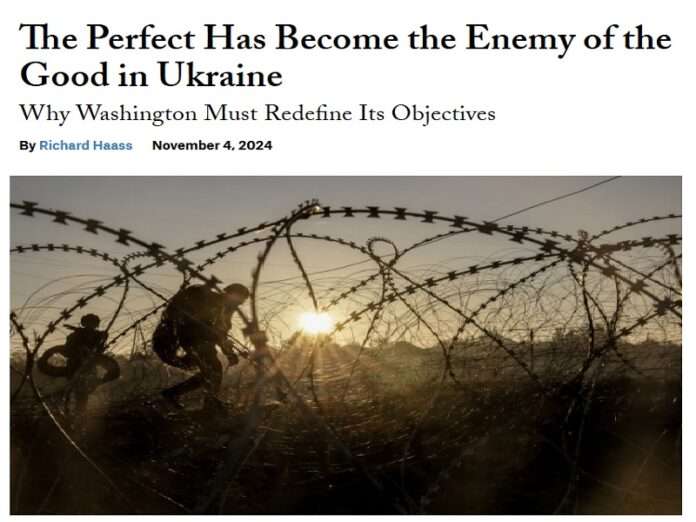Former Council on Foreign Relations (CFR) President Richard Haass recently published a detailed article for his think tank’s journal about how “The Perfect Has Become the Enemy of the Good in Ukraine: Why Washington Must Redefine Its Objectives”. He observed that the US never clearly defined what victory means, which has led to false expectations, deep disappointment, and confusion about the endgame. Haass then proceeds to explain why the US should push Ukraine to compromise with Russia.
According to him, it can’t realistically restore its pre-2014 borders, nor outlast Russia in the ongoing “war of attrition”. Zelensky’s much-ballyhooed “Victory Plan” “is not a plan for victory, but a prescription for continued war”, Haass wrote, warning that “If Kyiv’s allies walk away, it could end up being a prescription for defeat.” Instead, he suggests settling for Ukraine remaining “an independent, sovereign, and economically viable country”, which requires ending hostilities as soon as possible.
To that end, its Western partners “should tell Kyiv that Western support cannot be expected to continue at or near current levels without it. But they should also make an ironclad pledge to do everything in their power to provide Ukraine with arms for the long haul.” This includes giving it long-range weapons as a deterrent to Russia resuming the conflict at a later date. A buffer zone would also ideally be carved out along the Line of Contact, potentially with peacekeepers, but neither side would give up their claims.
Haass then proposes that the second diplomatic phase “could involve territorial transfers in both directions and a degree of autonomy for the inhabitants of Crimea and Ukraine’s east. It would also involve the creation of a security guarantee for Ukraine.” He added that this should involve formal NATO membership, but a coalition of the willing therein that provides credible security guarantees could suffice. Phased sanctions relief for Russia could also induce compliance with the ceasefire.
Moreover, “the West might ask Ukraine to forswear nuclear weapons” while NATO “could pledge not to station its forces on Ukraine’s territory”, which could meet some of Russia’s stated interests. Haass then ends by calling on Biden to implement this policy regardless of whoever his successor might be, arguing that he could take the heat for Kamala to carry out this much-needed policy change whereas Trump’s promised efforts to broker a peace deal would be shaped by the conditions that he inherits from Biden.
The former CFR chief deserves credit for saying what no policy influencer of his caliber has dared to, and his proposal for phased sanctions relief is also very pragmatic, but other parts of his proposed compromise are unrealistic. Russia’s Permanent UN Representative recently reaffirmed his country’s position that it won’t accept Ukraine being admitted to NATO in any shape or form. This means that it’ll never agree to its formal membership like Haass proposed even if troops aren’t based there.
Nevertheless, the argument can be made that the raft of bilateral security guarantees that Ukraine clinched with NATO members since the start of this year is practically equivalent to formal membership, with the only exception being that there’s no implied obligation to dispatch troops in its support. About that, Article 5 is misinterpreted by friends and foes alike as mandating the aforesaid, but all that it actually involves is each country deciding on its own the best way to support a beleaguered ally.
The bloc’s unprecedented military aid to Ukraine from early 2022 onwards de facto amounts to the implementation of Article 5 without crossing the line of sending troops there so formalizing this existing form of support through the abovementioned security guarantees simply solidifies the status quo. Russia obviously disapproves of it, but it hasn’t ramped up its surgical strikes against military targets or its battlefield operations in response, thus implying that it tacitly accepts this “new normal”.
Likewise, the West also tacitly accepts that its sanctions failed to inflict the strategic defeat on Russia that they expected, just like it also tacitly accepts that Ukraine won’t reconquer any of its lost regions. Awareness of these “politically incorrect” observations sets the stage for a potential compromise whereby the West and Russia can consider formalizing this state of affairs as the basis for an armistice since each can claim victory in their own way without the other “overreacting” like some have feared.
Russia won’t use nukes against Ukraine in response to that country formalizing its existing Article 5-like relationship with NATO while the West won’t deploy troops to help Ukraine reconquer its lost territory. Phased sanctions relief could incentivize Russia to abide by the armistice, while a mix of Western and non-Western (particularly BRICS countries) peacekeepers could possibly be deployed in the buffer zone. Ukraine might also be coerced to demilitarize part of its universally recognized border with Russia.
On the topic of autonomy for Crimea and Donbass that Haass touched upon in his piece, that’s already in effect since both Russian regions formalized such relations with the federal center upon their accession to the country. Haass is either unaware of this, forgot, or has something else in mind, but in any case, no changes are expected since this arrangement already works well for them. On the flipside, Russia wants Ukraine to grant its co-ethnics cultural autonomy at least, but this is unlikely.
None of the conflicting parties, which includes indirect participants like the West, will be fully satisfied with what was suggested by Haass or was proposed in this analysis in response to his piece. Even so, some of the compromises that were put forth could help lead to an armistice, though the challenge is preventing Russia and/or Ukraine from violating it out of fear that their rival is rearming under this cover ahead of a seemingly inevitable unannounced first strike. There’s no perfect solution to this dilemma.
Both sides will indeed rearm under this cover, but Russia could be positively influenced by phased sanctions relief at a comparatively accelerated pace while Ukraine could be restrained if the US has the political will and international peacekeepers do their duty monitoring compliance with the ceasefire. There’ll still remain the chance that one or the other could “go rogue” due to their unresolved security dilemma, but these additional proposals are the most realistic means for reducing that possibility.
All told, Haass’ proposed compromise is very imperfect, but it’s also still impressively better than anything that his peers have thus far put forth. Considering his influence in policy formulation, both directly and over those who are tasked with carrying this out, it’s possible that some of his ideas might be seriously considered or at least generate a debate about their merits among those who matter. The sooner that this happens, the sooner that the US can cut its losses while it still has the opportunity.







